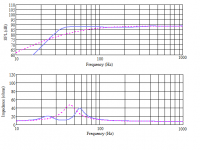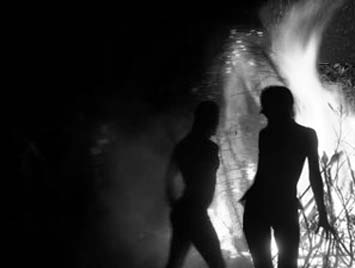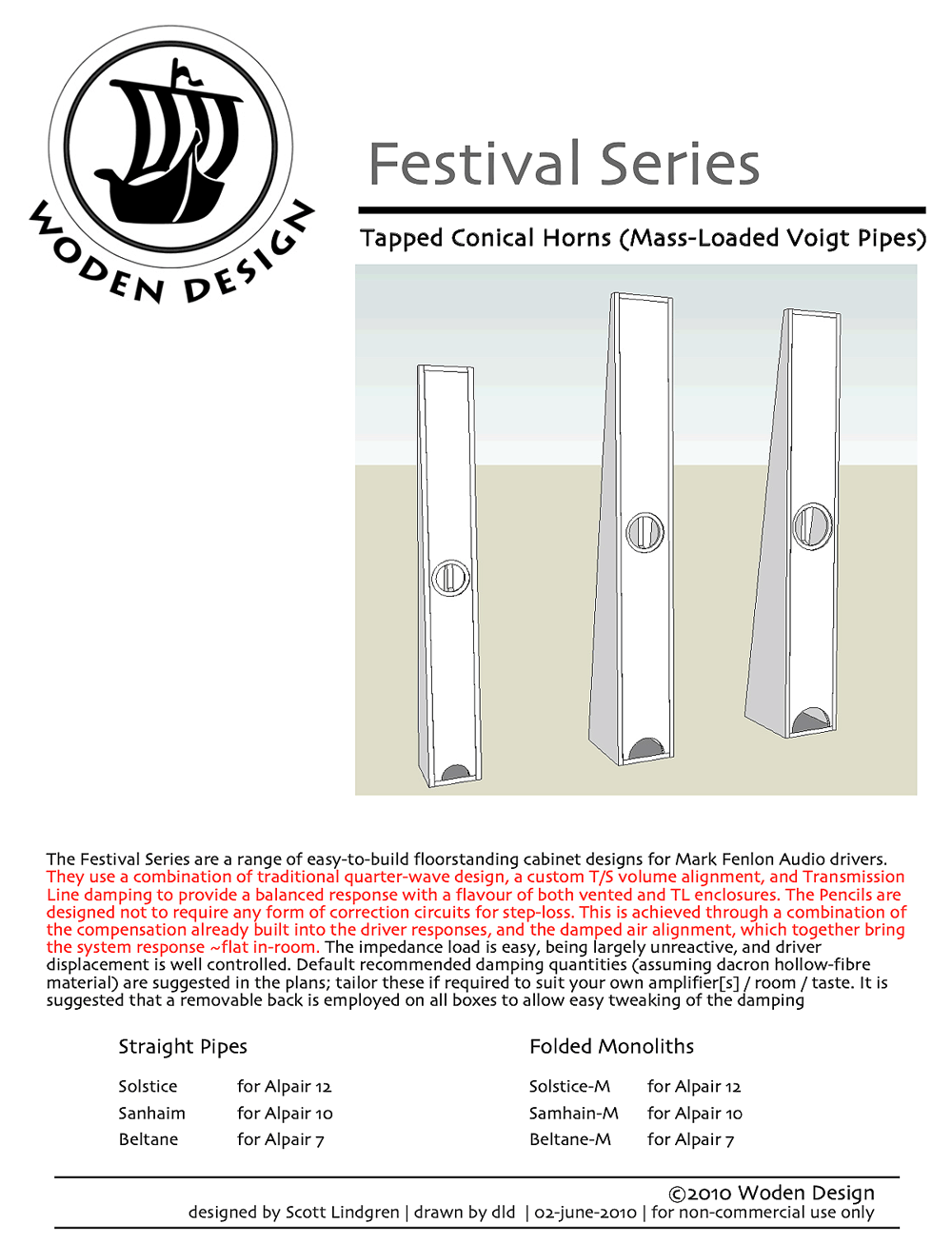Which ML-TQWT?
This one Scott?
Attachments
I'm also more thinking about a TQWT for this driver, preferable with a front port. But i can't find the info about it. All sites here mentioned in various tread end up on 404 errors. Is there a way to calculate it outside Hornresp (wich i can't get working like it should on my pc) to do the calculations?
I'm also more thinking about a TQWT for this driver, preferable with a front port. But i can't find the info about it. All sites here mentioned in various tread end up on 404 errors. Is there a way to calculate it outside Hornresp (wich i can't get working like it should on my pc) to do the calculations?
Ive always used this one by John Rutter based on D B Weems work. It will get you in the park, but was informed there are more accurate ways to model one these days.
Attachments
This one Scott?
Ah, the ML-Voigt (I tend to use TQWT to refer to the opposite of what most people mean by it). Frankly, there is no real acoustic advantage to the tapered design over an untapered MLTL in this particular case: I simply did it for people who wanted the aesthetics of the tall, triangular Voigt. If you just want a rectangular box, I suggest you build an MLTL. You won't lose or gain anything noteworthy. For reference, it's a maximally flat alignment (well, almost, I couldn't quite bring myself to it, so it's a bit better damped around tuning). Stated Fb is conservative, it's actually about 36Hz, but I prefer to understate to give a little tolerance.
The Rutter based spreadsheet is basically of little value, keying axial length off Fs, terminus CSA from 2.5Sd, with no account made for driver Qt, Vas, nor is the effect of throat CSA on line taper, vent length and Fp accounted for. If you want a better starting point & don't want to spend some time learning the baseline physics, use Martin's alignment tables to give you some starting values, which will be much more usable in the majority of conditions, or empirically design in Hornrsp etc.
Attachments
Last edited:
I found those, but i don't understand it. I know the basic principles of a TL, but he makes it so difficult that for an non-electronic engineer it hard to understand. He also uses expressions that i don't now (wat so and sl?) without any explenation. Is there no "TL for dummy's" manual somewhere?
And that that sheet above is not really accurate i could see. I can also calculate what a quarter wavelength is of a frequency, and what the sd is. That is not the issue. I found some other calculators, but they are doing the same.
I wish that mathcad file was still there. Everybody refers to it but the file itself is gone it seems...
And that that sheet above is not really accurate i could see. I can also calculate what a quarter wavelength is of a frequency, and what the sd is. That is not the issue. I found some other calculators, but they are doing the same.
I wish that mathcad file was still there. Everybody refers to it but the file itself is gone it seems...
I did ask in another thread WRT Sonodo SWR-200a/JOAN horn after you said that combination could benifit a bit more from boundry loading, it went unanswered:And speaking as the person who designed it, I venture to say 'wrong.' 😉 You can always ask you know, you don't need to speculate. I don't bite. Not now Haloween is over for another year anwayway.
Tonal balance in a broad sense is OK, it just a little over-damped < 100Hz relative to the 12P given the similar Q, Fs, but higher Vas. Not badly so, it'll just benefit a bit more from boundary loading.
I used the term "drop-in replacement" in that it was said to work in "Joan" horn and because the driver cutout would be very close to that of the A12p. Simple retrofit without the need for switching between multiple supra-baffle's cut to each specific driver.
For me that in itself makes the Joan horn more desirable to build for my MarkAudio A12p than a Pencil/12p. Down the road some after enjoying the A12p/Joan horn, I'd then have a painless way to play around with the Sonodo SWR-200a without investing the time and resources on a specific box build. If I were to find the Sonodo 200a superior sounding to 12p I'd then have the option of doing a specific build or sticking with Joan. On paper, I like the higher sensitivity of the 200a for use with my single-digit SET amps.
...so either corner placement to utilize the corer walls as a last fold of the horn, or Ron Clark'esque triangle deflectors against a rear wall and directly behind the rear mouth of the Joan horn?
Reading the following description certainly leaves one to question what's being said:
Joan is the big cousin the existing FH family.
-
It is not the same alignment as the others in the family, less bass gain,
dave
they don't do bass well.
FHs do bass well. Particularily when we talk FHXL (and Joan too i would expect, we should hear soon).
dave
I still like the look of the ML-TQWT being old school and would like to know how to fold it and keep the design parameters. But I'm always open to persuasion if there is an even better option?
The Pensils and the Festivals are related. email me ref proper folding.
dave
Ive always used this one by John Rutter based on D B Weems work.
Next to useless.
dave
Re p.46, I'm afraid you have misunderstood what was written.
Your query was about the Sonido unit in this enclosure, and the reply you received was specifically in relation to that combination. The Sonido in question has a higher Qt, Vas than the design unit, and has a slightly over-damped LF response in this enclosure. That combination will therefore benefit from slightly more boundary loading as a result. You should not assume this applies in a general sense.
The reference Dave made to 'less bass gain' is that FH3 and FHXL were designed from the outset to trade extension for efficiency: they are higher gain alignments (higher than the nominal SPL) tuned relatively high. If you cast your eye on the original FH3 thread, you'll note some of the original design objectives set out, of which this was one. Most compact bass horns are tuned too low / have their expansion too heavily compromised, limiting output below c. 100Hz. Ergo when I came to design FH3 with Dave and Chris, I decided to tune somewhat higher and as a result get more usable output. More or less the same applies to FHXL, albeit by matter of degree. This box, however, departs somewhat from that goal because a majority of people with 6 1/2in or > drivers want more extension, so rather than the higher gain alignment of the smaller boxes, it uses a near-maximally flat alignment with the design Alpair 12P.
Re 'went unanswered', alas, I can't spend my life on DIYaudio, and being human I can't spot every single question asked unfortunately. Please do ask again or email however if you don't receive a reply instanta.
Your query was about the Sonido unit in this enclosure, and the reply you received was specifically in relation to that combination. The Sonido in question has a higher Qt, Vas than the design unit, and has a slightly over-damped LF response in this enclosure. That combination will therefore benefit from slightly more boundary loading as a result. You should not assume this applies in a general sense.
The reference Dave made to 'less bass gain' is that FH3 and FHXL were designed from the outset to trade extension for efficiency: they are higher gain alignments (higher than the nominal SPL) tuned relatively high. If you cast your eye on the original FH3 thread, you'll note some of the original design objectives set out, of which this was one. Most compact bass horns are tuned too low / have their expansion too heavily compromised, limiting output below c. 100Hz. Ergo when I came to design FH3 with Dave and Chris, I decided to tune somewhat higher and as a result get more usable output. More or less the same applies to FHXL, albeit by matter of degree. This box, however, departs somewhat from that goal because a majority of people with 6 1/2in or > drivers want more extension, so rather than the higher gain alignment of the smaller boxes, it uses a near-maximally flat alignment with the design Alpair 12P.
Re 'went unanswered', alas, I can't spend my life on DIYaudio, and being human I can't spot every single question asked unfortunately. Please do ask again or email however if you don't receive a reply instanta.
Last edited:
Ah, the ML-Voigt (I tend to use TQWT to refer to the opposite of what most people mean by it). Frankly, there is no real acoustic advantage to the tapered design over an untapered MLTL in this particular case: I simply did it for people who wanted the aesthetics of the tall, triangular Voigt.
Thanks Scott. Sadly I forget more than I learn these days which isnt very helpful. I do prefer the straight pipe. Easier construction too. Convincing the wife though....... ?
The Pensils and the Festivals are related. email me ref proper folding.
dave
Not seen the Festivals? Yes will email you you re folding If I cant persuade the other half to the tall Voigts? She does after all have to live with the Lowthers already 🙂
Festival is the generic family name for the tall ML-Voigts. There was a short-lived planset for A12/10/7. We are working on a new series for current drivers, and the CHN110 ML-Voigt is a teaser (there are a few others)
dave
dave
Festival is the generic family name for the tall ML-Voigts. There was a short-lived planset for A12/10/7. We are working on a new series for current drivers, and the CHN110 ML-Voigt is a teaser (there are a few others)
dave
Oh I see, I never realised the straight pipes were called Festivals. I love TQWTs, as they remind me of horns even if they have more in common with BR. The new Lounge where we are moving soon is 16ft x 9ft so I have to be conscious of the front to back dimension, which is a shame as I like the look of the FH series. But I will watch with interest. BTW I havent forgot about the phase plugs I still want a pair so will be in touch.
I love TQWTs, as they remind me of horns even if they have more in common with BR
They are tapped horns. Mass loading is added to greatly decrease LF ripple.
dave
Nice thanks Dave. Scott/Dave would you mind giving me the Dimensions for that mouth/port really like that over a BR tube.
Last edited:
Sometimes that is not doable. But the half-moon vents are just like the slot on the Pensils but in the shape of a semi-circle.
Material thickness, same area.
dave
Material thickness, same area.
dave
Apparently so. Terminology! Thank you for the clarification, you've renewed my interest.Re p.46, I'm afraid you have misunderstood what was written.
-
It's a shame the deep footprint is difficult to accommodate in the smaller "modest" sized rooms that this could actually work for those of us looking for higher sensitivity easy impedance load speakers to pair with our low power SET amps.
Oh I see, I never realised the straight pipes were called Festivals. I love TQWTs, as they remind me of horns even if they have more in common with BR. The new Lounge where we are moving soon is 16ft x 9ft so I have to be conscious of the front to back dimension, which is a shame as I like the look of the FH series. But I will watch with interest. BTW I havent forgot about the phase plugs I still want a pair so will be in touch.
As Dave notes, they're technically speaking [single] tapped, mass loaded horns. A pipe that expands toward the terminus is technically a horn: it just doesn't happen to be impedance matched down to its QW cutoff frequency. The driver is tapped into the expansion path at a given distance from the throat (thus 'tapped'; by contrast a Danley Sound Labs box is a double-tapped horn, as the driver excites the horn at two physically different positions along its expansion path). The terminus has a ducted vent of smaller cross section, the air mass in which is the 'mass loading' part.
- Home
- Loudspeakers
- Full Range
- The new Mark Audio CHN-110 6" driver


